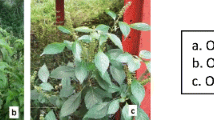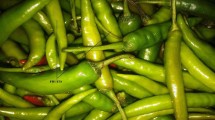Abstract
The aim of the present study was to demonstrate acaricidal activity on the cattle tick Rhipicephalus (Boophilus) microplus of essential oils from endemic conifers of New Caledonia in the context of the development of natural alternatives. Acaricidal activity of essential oils extracted from resin and heartwood of five endemic conifers of New Caledonia (Araucaria columnaris, Agathis moorei, Agathis ovata, Callitris sulcata, and Neocallitropsis pancheri) was evaluated on 14- to 21-day-old Rhipicephalus microplus tick larvae using the Larval Packal Test bioassay. A first screening with 5 % dilute solution was carried out and the oils with 100 % of mortality at this rate were diluted until no activity was shown. The heartwood oils of the two Cupressaceae were the most active with LC50 value of 0.65 % for C. sulcata and 0.55 % for N. pancheri while resin oil of A. columnaris (LC50 = 1.62 %) was the most active of the Araucariaceae family. Negative control (ethanol) was not toxic to the larvae. The chemical composition of essential oil from resin of A. columnaris was analyzed by gas chromatography–mass spectrometry. The essential oil was characterized by high level of sesquiterpene hydrocarbons and oxygenated sesquiterpenes and was composed mainly of aromadendrene (23.1 %) and bicyclogermacrene (16.0 %). In order to compare different plant resources in a sustainable program of natural acaricide, an “essential oil efficiency EOE” can be measured as the ratio between the yield of extraction and LC50 value. This study shows that A. columnaris (EOE = 2.36) and N. pancheri (EOE = 3.51) could provide valuable and effective natural acaricides for control of the cattle tick R. microplus.

Similar content being viewed by others
References
Adams RP (2007) Identification of essential oil components by gas chromatography-quadrupole mass spectroscopy, 4th edn. Allured, Carol Stream, IL, USA
Apel MA, Ribeiro VL, Bordignon SA, Henriques AT, von Poser G (2009) Chemical composition and toxicity of the essential oils from Cunila species (Lamiaceae) on the cattle tick Rhipicephalus (Boophilus) microplus. Parasitol Res 105:863–868
Barré N, Uilenberg G (2010) Propagation de parasites transportés avec leurs hôtes: cas exemplaires de deux espèces de tiques du bétail. Revue Scientifique et Technique de l'OIE 29:135–147
Barré N, Happold J, Delathiere JM, Desoutter D, Salery M, de Vos AJ, Marchal C, Graille M, Mortelecque A (2011) A campaign to eradicate bovine babesiosis from New Caledonia. Ticks and Tick-borne Diseases 2:55–61
Dolan MC, Dietrich G, Panella NA, Montenieri JA, Karchesy JJ (2007) Biocidal activity of three wood essential oils against Ixodes scapularis (Acari: Ixodidae), Xenopsylla cheopis (Siphonaptera: Pulicidae) and Aedes aegypti (Diptera: Culicidae). J Econ Entomol 100:622–625
Finney DS (1971) Probit analysis, 3rd edn. Cambridge University Press, Cambridge
Gazim ZC, Demarchi IG, Lonardoni MV, Amorim AC, Hovell AM, Rezende CM, Ferreira GA, de Lima EL, de Cosmo FA, Cortez DA (2011) Acaricidal activity of the essential oil from Tetradenia riparia (Lamiaceae) on the cattle tick Rhipicephalus (Boophilus) microplus (Acari; Ixodidae). Exp Parasitol 129:175–178
Gomes GA, de Oliveira Monteiro CM, de Oliveira Souza Senra T, Zeringota V, Calmon F, da Silva MR, Daemon E, da Silva Gois RW, Pinheiro Santiago GM, de Carvalho MG (2012) Chemical composition and acaricidal activity of essential oil from Lippia sidoides on larvae of Dermacentor nitens (Acari: Ixodidae) and larvae and engorged females of Rhipicephalus microplus. Ixodidae, Acari
Grisi L, Massard CL, Moya-Borja GE, Pereira JB (2002) Impacto economico das principais ectoparasitoses em bovinos no Brasil. A Hora Veterinária 21:8–10
Hnawia E, Menut C, Agrebi A, Cabalion P (2008) Wood essential oils of two endemic trees from New Caledonia: Callitris sulcata (Parl.) Schltr and Callitris neocaledonica Dummer. Biochem Syst Ecol 36:859–866
Joulain D, König WA (1998) The atlas of spectral data of sesquiterpene hydrocarbons. E.B., Hamburg, Germany
König WA, Joulain D, Hochmuth DH (2004) Terpenoids and related constituents of essential oils. Mass Finder 3, Hamburg, Germany
Lage TCA, Montanari RM, Fernandes SA, de Oliveira Monteiro CM, de Oliveira Souza Senra T, Zeringota V, Calmon F, da Silva Matos R, Daemon E (2012) Activity of essential oil of Lippia triplinervis Gardner (Verbenaceae) on Rhipicephalus microplus (Acari: Ixodidae). Parasitol Res. doi:10.1007/s00436-012-3209-y
Lebouvier N, Menut C, Hnawia E, Illinger A, Cabalion P, Nour M (2010) Chemical investigations of essential oils from endemic Cupressaceae trees from New Caledonia. Nat Prod Commun 5:949–956
Lee CH, Park JM, Song HY, Jeong EY, Lee HS (2009) Acaricidal activities of major constituents of essential oil of Juniperus chinensis leaves against house dust and stored food mites. J Food Prot 72:1686–1691
Martinez Velazquez M, Castillo Herrera GA, Rosario Cruz R, Flores Fernandez JM, Lopez Ramirez J, Hernandez Gutierrez R, Lugo Cervantes Edel C (2011a) Acaricidal effect and chemical composition of essential oils extracted from Cuminum cyminum, Pimenta dioica and Ocimum basilicum against the cattle tick Rhipicephalus (Boophilus) microplus (Acari: Ixodidae). Parasitol Res 108:481–487
Martinez Velazquez M, Rosario Cruz R, Castillo Herrera GA, Flores Fernandez JM, Alvarez AH, Lugo Cervantes Edel C (2011b) Acaricidal effect of essential oils from Lippia graveolens (Lamiales: Verbenaceae), Rosmarinus officinalis (Lamiales: Lamiaceae), and Allium sativum (Liliales: Liliaceae) against Rhipicephalus (Boophilus) microplus (Acari: Ixodidae). J Med Entomol 48:822–827
Panella NA, Karchesy J, Maupin GO, Malan JC, Piesman J (1997) Susceptibility of immature Ixodes scapularis (Acari: Ixodidae) to plant-derived acaricides. J Med Entomol 34:340–345
Pontes WJT, Silva JMO, da Camara CAG, Gondim-Junior MGC, Oliveira JV, Schwartz MOE (2010) Chemical composition and acaricidal activity of the essential oils from fruits and leaf of Protium bahianum Daly. JEOR 22:279–282
Raharivelomanana P, Cambon A, Azzaro M, Bianchini JP, Claude-Lafontaine A, George G (1993) Volatile constituents of Neocallitropsis pancheri (Carriere) de Laubenfels heartwood extracts (Cupressaceae). JEOR 5:587–595
Ribeiro VL, Rolim V, Bordignon S, Henriques AT, Dorneles GG, Limberger RP, von Poser G (2008) Chemical composition and larvicidal properties of the essential oils from Drimys brasiliensis Miers (Winteraceae) on the cattle tick Rhipicephalus (Boophilus) microplus and the brown dog tick Rhipicephalus sanguineus. Parasitol Res 102:531–535
Ribeiro VL, Dos Santos JC, Bordignon SA, Apel MA, Henriques AT, von Poser GL (2010) Acaricidal properties of the essential oil from Hesperozygis ringens (Lamiaceae) on the cattle tick Riphicephalus (Boophilus) microplus. Bioresour Technol 101:2506–2509
Ribeiro VL, dos Santos JC, Martins JR, Schripsema J, Siqueira IR, von Poser GL, Apel MA (2011) Acaricidal properties of the essential oil and precocene II obtained from Calea serrata (Asteraceae) on the cattle tick Rhipicephalus (Boophilus) microplus (Acari: Ixodidae). Vet Parasitol 179:195–198
Stone BF, Haydock P (1962) A method for measuring the acaricide susceptibility of the cattle tick Boophilus microplus (Can.). Bull Entomol Res 53:563–578
Waikedre J, Vitturo CI, Molina A, Norato Estrela Terra Theodoro P, do Rosário Rodrigues Silva M, Salmen Espindola L, Maciuk A, Fournet A (2012) Antifungal Activity of the Essential Oils of Callitris neocaledonica and C. sulcata Heartwood (Cupressaceae). Chem Biodivers 9:644–653
Acknowledgments
The authors would like to thank Anowo Ltd for providing nylon paper and the Herbarium NOU for confirmation of voucher specimen identifications.
Author information
Authors and Affiliations
Corresponding author
Rights and permissions
About this article
Cite this article
Lebouvier, N., Hue, T., Hnawia, E. et al. Acaricidal activity of essential oils from five endemic conifers of New Caledonia on the cattle tick Rhipicephalus (Boophilus) microplus . Parasitol Res 112, 1379–1384 (2013). https://doi.org/10.1007/s00436-012-3268-0
Received:
Accepted:
Published:
Issue Date:
DOI: https://doi.org/10.1007/s00436-012-3268-0




